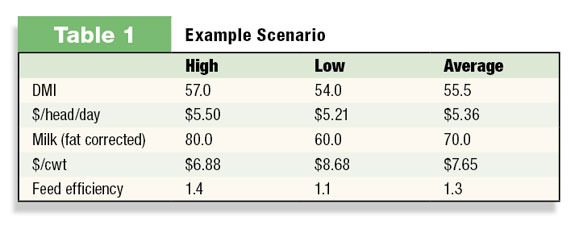In this article, we discuss the intricate relationships between milk production, dry matter (DM) intake and bodyweight, and how your animals’ nutritional needs are determined by stage of lactation and level of production. The first part of the article will describe the lactation cycle, followed by an example of how feeding your animals properly will keep your animals healthy and keep money in your pocket.
When a cow calves, she enters a period of negative energy status, caused by DM intake limiting her ability to meet the demands of lactation. This will be the case for approximately the next 10 weeks of lactation. Energy is partitioned to the mammary gland for milk synthesis, and because she cannot consume enough DM to meet the demand of lactation, she takes it from her body reserves, and bodyweight decreases.
For this reason, she is at a high risk for metabolic diseases, especially during the transition period. The transition period is comprised of the three weeks before and after calving, and is the time when milk fever, ketosis, retained fetal membranes, metritis and displaced abomasum primarily affect cows.
After production peaks at around 56 days in milk (DIM), the cow’s production slowly tapers off. This is matched with increased intake, which reaches the highest levels between weeks 10 and 20 of lactation. During this time, the cow is in a state of balanced energy status (bodyweight is maintained).
The third period, positive energy balance, is when the cow compensates for the bodyweight lost in the previous two periods. Dry matter intake continues to taper off, but is at a level that allows for milk production (decreasing), continued weight gain, as well as maintenance of pregnancy. Weight gain continues throughout the dry period as the cow approaches the transition period.
Despite the fact that nutrient requirements change as an animal proceeds through her lactation, it is not uncommon for dairy producers to feed all lactating cows one ration. The idea behind this practice is that by feeding one ration to the herd, there is little chance of under-feeding the lower-producing cows, ensuring maximum milk production. However, the cost of this practice is rarely justified with more milk, or more importantly, increased profits. Let’s work through an example to illustrate our point (all milk production numbers are presented as fat-corrected milk).

In our example, we will assume the lactating herd is broken up into two groups, high-production and late-lactation. Currently, they are fed one ration designed to meet the requirements of the highest-producing cows in the herd (80 pounds milk). The ration costs $5.50 per head per day for high cows consuming 57 pounds of dry matter. The late-lactation cows are producing 60 pounds of milk and eating 54 pounds of dry matter (see Table 1).
In this example, the average feed cost to produce 100 pounds of milk is $7.65 per head per day. While the average feed cost per hundredweight in our herd is $7.65, the cost for the high string is $6.88 while the low string is $8.68. This large divide in the cost to produce milk is caused by two factors:
- Late-lactation cows are producing less milk, while their intakes are relatively high.
- These cows are consuming a diet that is supplying nutrients above their requirements, and the extra energy, protein, etc. is going on their back in the form of fat and out into the environment in the form of feces.
The opportunity to decrease the cost per hundredweight and save feed comes from feeding your lower-producing cows a ration that is designed to meet their required intake levels (three pounds lower than your high cows) and is less nutrient-dense. In general, lower-cost ingredients contain fewer nutrients, and can be fed at higher levels to the lower-producing cows, based on their biological needs.
A great way to determine if you are feeding excess protein is to measure milk urea nitrogen (MUN). Milk urea will run between 10 and 14 mg/dl. A sample above 14 mg/dl is an indication that excess protein is being fed, and it may be beneficial to reevaluate the ration.
Another tool to evaluate the nutritional status of your herd is to measure feed efficiency. Feed efficiency is the amount of milk produced (fat corrected), divided by the amount of dry feed consumed on a daily basis. Using our example herd, the average feed efficiency is 1.26 pounds of milk per pound of DM consumed. For comparison, the low string is 1.11 while the high string is 1.4 pounds of milk per pound of DM feed consumed. The benchmark for feed efficiency is somewhere in the range of 1.4 to 1.6 pounds of milk per pound of DM feed consumed, but will fluctuate depending on stage of lactation and animal age.
In the above situation, we are overfeeding nutrients to an already less-efficient group of animals. While changing nutrient density will not affect feed efficiency (still consuming the same amount of DM), it will decrease the cost of feed (lower-priced ingredients), thus increasing your return on investment.
The information in this article is presented to help you better understand the principles of proper feeding management. In the example above, feeding one ration to the entire lactating herd was increasing the cost of producing milk. Feeding according to animal requirements is good for the animal, the bulk tank, as well as the pocketbook. PD
—Excerpts from University of California Cooperative Extension Dairy Newsletter, May 2010





